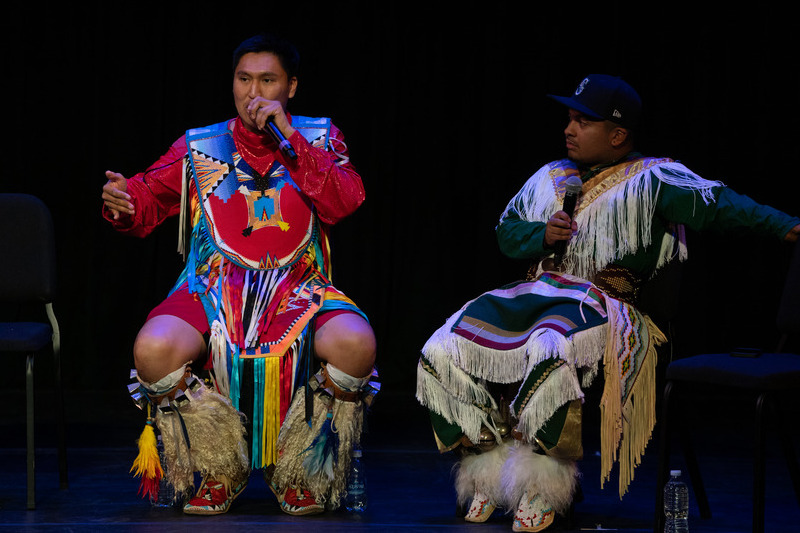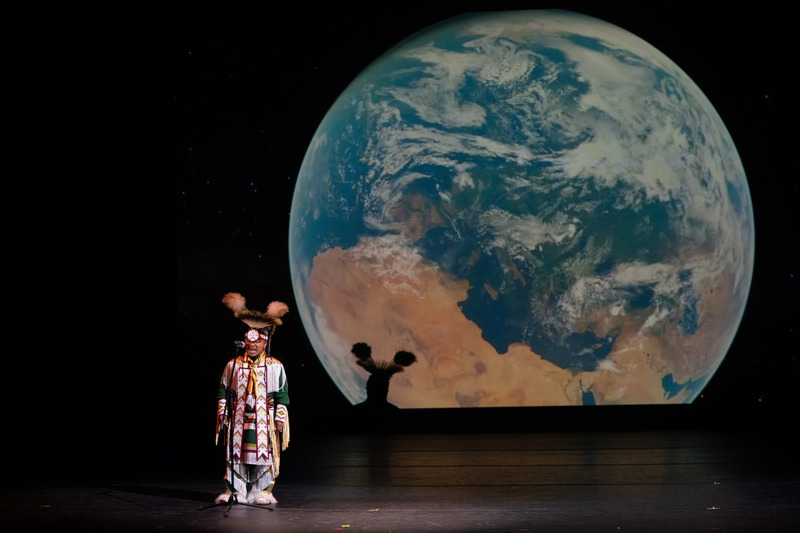


Thriving through dance
Photos by Mikey Reeves December 05, 2023
UD community learns how Native American communities persevere and keep traditions alive
Renowned Native American dance troupe Indigenous Enterprise uses dance to showcase how indigenous dance styles are inextricable to their culture and to share a part of American history that at one time was in danger of being lost.
The group brought those lessons to the University of Delaware in October as a highlight of National Arts and Humanities month.
The troupe was in residence at UD for two days, visiting area K-12 schools, holding workshops with UD students and putting on a public performance of powwow dancing in Mitchell Hall. Members of the Chippewa-Cree Tribe, the Diné Nation, the Navajo Nation and the Poundmaker Cree Nation displayed dance styles including the jingle dress dance, men’s fancy dancing and the hoop dance, among others, and a video projection provided historical context for the various styles.
Barry Joyce, professor of history, and Suzanne Burton, senior associate dean for the arts, arranged the visit. Joyce explained that during the late 19th century, there was a conscious effort in the United States to essentially eradicate native culture, to put it in museums and think of it as history. Children were taken from their families and raised in residential schools, and traditional dancing was restricted and sometimes completely outlawed.
“In history books, it looks like we disappeared in 1900. You don’t read anything about Native cultures after that," said Quinton Duran, a member of Indigenous Enterprise from the Laguna Pueblo Tribe of New Mexico.
“There are so many misconceptions about native people. Indigenous Enterprise brought global experience and an educational component to campus and offered students the chance to learn first-hand about some of the issues native communities face,” Joyce said.
Modern powwows began when Indigenous people met secretly to preserve their culture, and today dance competitions take place across Turtle Island, the native term for North America. Speaking at a workshop with UD dance students, members of Indigenous Enterprise explained that powwow dancing is more than movement. It is prayer and healing. They describe feeling almost meditative during a dance.
“When I’m dancing I’m not thinking of the audience at all,” said dancer Nanabah Keediniihii.

“Powwow dancing is about filling the space with your body. It feels the vibration of the drums and uses every muscle,” Duran added.
Denise Murphy-Rohr, director of dance at UD, said the workshop reinforced an important lesson she imparts to her students: That dance is integral to culture and community.
“By developing a deeper understanding of dance within many contexts, students can examine how dance is part of their own identity,” she said.
Junior dance minor Marissa Jackson agreed.
“It was so enlightening to see people be so proud of their culture and unapologetically show it to others and why it is important,” she said. “It reminds me to embrace myself in my own dancing and make every movement mean something.”
Jackson was also struck by the stamina needed to perform powwow dances. A standard jingle dress, for example, has 365 metal shells sewn onto it and weighs about 30 pounds, and some are even more elaborate.
Students and faculty at a workshop centered on art, music and fashion saw a jingle dress and other pieces of clothing worn during powwow dancing, which the dancers call their regalia.
“A costume is what you wear on Halloween — when you pretend to be someone else,” said group founder Kenneth Shirley. “When I wear my regalia, I feel more like myself.”
Every design element in regalia has significance, and items with intricate beadwork can take months or more than a year to create. Floral or geometric patterns follow tribal traditions or are passed down in families. Duran’s black and white moccasins reflect the pottery of the Laguna Pueblo Tribe, with black representing land and white representing sky, and an “x” pattern symbolizing hills.
Members of Indigenous Enterprise are champion dancers, having won prizes at powwows across Turtle Island. They have performed around the world, appeared in a Nike commercial and last February were the first Native American group to dance at a Super Bowl. Yet, they want audiences to Native communities still face challenges.
“There are big problems for us as a community, and it gets brushed under the rug,” Shirley said. “My grandma on the reservation has no running water or electricity. A lot of our elders don’t even have these basics.”
Shirley urged audience members who want to help to educate themselves on these issues and find organizations that support indigenous communities.
Despite the hardships, troupe members focus on power and hope, and the performance reveals that Native culture is thriving and vibrant.
“With all that we experienced as indigenous people, it is through dance that we were able to survive,” Shirley said. “We represent our past. We are the present. And we will continue to thrive in our future.”
Contact Us
Have a UDaily story idea?
Contact us at ocm@udel.edu
Members of the press
Contact us at 302-831-NEWS or visit the Media Relations website

